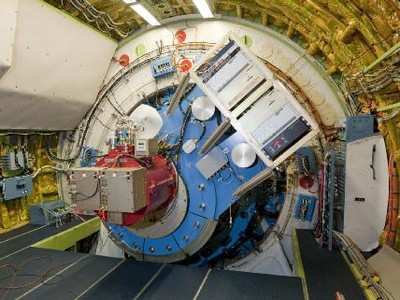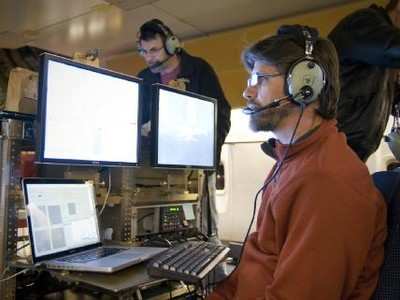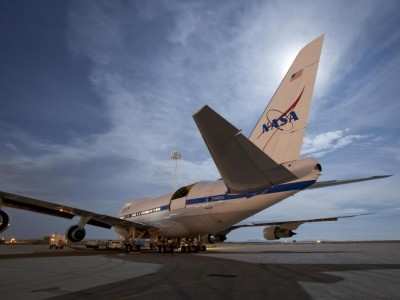Heavily-Modified B747SP Has Two More Missions Scheduled
NASA's Stratospheric Observatory for Infrared Astronomy, or
SOFIA, completed the first of three science flights on Wednesday
morning to demonstrate the aircraft's potential to make discoveries
about the infrared universe.

NASA SOFIA In Flight NASA Image
The airborne observatory is an international collaboration
between NASA and the German Aerospace Center, Deutsches Zentrum fur
Luft und Raumfahrt (DLR). SOFIA is a heavily modified Boeing 747SP
that cruises at altitudes between 39,000 and 45,000 feet. It will
allow researchers to better understand a wide range of astronomical
phenomena including how stars and planets are born, how organic
substances form in interstellar space, and how supermassive black
holes feed and grow. This premiere science flight took off from an
Air Force runway in Palmdale, CA, on Nov. 30, flying for
approximately 10 hours.
"These initial science flights mark a significant milestone in
SOFIA’s development and ability to conduct peer-reviewed
science observations," said NASA Astrophysics Division Director Jon
Morse. "We anticipate a number of important discoveries from this
unique observatory, as well as extended investigations of
discoveries by other space telescopes."

Cornell University's Faint Object Infrared
Camera
SOFIA is fitted with a 100-inch diameter airborne infrared
telescope. It is based and managed at NASA's Dryden Aircraft
Operations Facility in Palmdale. The aircraft's instruments can
analyze light from a wide range of celestial objects, including
warm interstellar gas and dust of bright star forming regions, by
observing wavelengths between 0.3 and 1,600 microns. A micron
equals one millionth of a meter. For comparison, the human eye sees
light with wavelengths between 0.4 and 0.7 microns.
The first three science flights, phase one of SOFIA's early
science program, will employ the Faint Object InfraRed Camera for
the SOFIA Telescope (FORCAST) instrument developed by Cornell
University and led by principal investigator Terry Herter. FORCAST
observes the mid-infrared spectrum from five to 40 microns.

Cornell University Researcher Luke Keller
Researchers used the FORCAST camera on SOFIA during a test
flight two weeks ago to produce infrared images of areas within the
Orion star-formation complex, a region of the sky for which more
extensive data were collected during the Nov. 30 flight. "The early
science flight program serves to validate SOFIA's capabilities and
demonstrate the observatory's ability to make observations not
possible from Earth-based telescopes," said Bob Meyer, NASA's SOFIA
program manager. "It also marks SOFIA's transition from flying
testbed to flying observatory, and it gives the international
astronomical research community a new, highly versatile platform
for studying the universe."
In February 2011, the German Receiver for Astronomy at Terahertz
Frequencies (GREAT), developed under the lead of the
Max-Planck-Institut fur Radioastronomie, Bonn, Germany, will be
installed in the observatory for three flights during the second
phase of the program. "The first science flight showed that the
SOFIA observatory works very well," said Alois Himmes, SOFIA
project manager at DLR. "It also demonstrated the excellent
collaboration between the U.S. and German partners and the intense
work of the teams during the past weeks."

NASA Image
NASA's Ames Research Center in Moffett Field, CA, manages the
SOFIA science and mission operations in cooperation with the
Universities Space Research Association in Columbia, Md., and the
Deutsches SOFIA Institut at the University of Stuttgart,
Germany.
 ANN's Daily Aero-Linx (04.16.24)
ANN's Daily Aero-Linx (04.16.24) Aero-News: Quote of the Day (04.16.24)
Aero-News: Quote of the Day (04.16.24) Airborne 04.10.24: SnF24!, A50 Heritage Reveal, HeliCycle!, Montaer MC-01
Airborne 04.10.24: SnF24!, A50 Heritage Reveal, HeliCycle!, Montaer MC-01 Airborne 04.12.24: SnF24!, G100UL Is Here, Holy Micro, Plane Tags
Airborne 04.12.24: SnF24!, G100UL Is Here, Holy Micro, Plane Tags Airborne-Flight Training 04.17.24: Feds Need Controllers, Spirit Delay, Redbird
Airborne-Flight Training 04.17.24: Feds Need Controllers, Spirit Delay, Redbird






